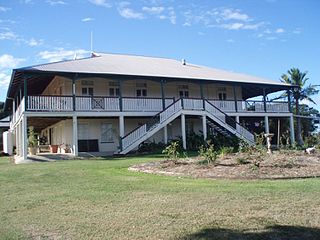
The Capricorn Coast is a stretch of coastline in Central Queensland, Australia and is part of the Shire of Livingstone.

Shoalwater Bay is a large bay on the Capricorn Coast of Central Queensland, Australia 100 km north of the coastal town of Yeppoon and 628 km north-north-west of the state capital, Brisbane. Since 1966, the land surrounding Shoalwater Bay has been under the ownership of the Australian Defence Force, for the purpose of military training exercises. Shoalwater Bay is also a noted dugong habitat and is part of the Great Barrier Reef Marine Park. The bay is bounded by the Torilla Peninsula to the west and the Warginburra Peninsula and Leicester and Townshend islands to the east.
Shoalwater Bay Military Training Area is a heritage-listed military installation at Byfield Road, Byfield, Shire of Livingstone, Queensland, Australia. It is a large, relatively undisturbed and intact natural system with a wide variety of coastal landforms and a high level of biodiversity. It contains a diverse range of marine and coastal wetland landscapes, vegetation types and ecosystems. It was added to the Australian Commonwealth Heritage List on 22 June 2004.

Glenmore Homestead is a heritage-listed homestead at Belmont Road, Parkhurst, Rockhampton Region, Queensland, Australia. It was built from c. 1858 to c. 1920. The homestead and associated buildings once belonged to pastoral run on the Fitzroy River, seven kilometres northwest of Rockhampton, Queensland. Originally much larger at 127 square miles the current size of the property is 20 acres (8.1 ha). It was added to the Queensland Heritage Register on 21 October 1992.

Bellevue Homestead is a heritage-listed homestead currently located in Coominya, Somerset Region, Queensland, Australia. It was built from c. 1872 to c. 1910. It was added to the Queensland Heritage Register on 21 October 1992.

Byfield is a rural locality in the Shire of Livingstone, Queensland, Australia. In the 2016 census, Byfield had a population of 301 people.

Jondaryan Woolshed is a heritage-listed shearing shed at Evanslea Road, Jondaryan, Queensland, Australia. It was built in 1859-60 to replace an earlier, smaller woolshed on the former Jondaryan pastoral station, which was at one stage the largest freehold station in Queensland. The woolshed was the scene of significant labour conflict in the late 1880s and early 1890s, as the station became a test case for the new Queensland Shearers Union in the lead-up to the 1891 Australian shearers' strike.

Braeside Homestead is a heritage-listed homestead at Crystal Mount Road, Dalveen, Southern Downs Region, Queensland, Australia. It was built from 1870s to 1920s. It was added to the Queensland Heritage Register on 23 August 2002.

Cressbrook Homestead is a heritage-listed homestead at off Cressbrook-Caboombah Road, Cressbrook, Somerset Region, Queensland, Australia. It was built from 1841 to 1914. It was added to the Queensland Heritage Register on 21 October 1992.

Monsildale Homestead is a heritage-listed homestead at 2532 Monsildale Road, Monsildale, Somerset Region, Queensland, Australia. It was added to the Queensland Heritage Register on 3 April 2009.

Murrumba Homestead Grounds is a heritage-listed site at 38 Armstrong Street, Petrie, Moreton Bay Region, Queensland, Australia. It was added to the Queensland Heritage Register on 16 February 2009.

Kenilworth Homestead is a heritage-listed homestead at Eumundi Kenilworth Road, Kenilworth, Sunshine Coast Region, Queensland, Australia. It was built c. 1865. It was also known as Kenilworth Station. It was added to the Queensland Heritage Register on 30 November 1998.

Raglan Homestead is a heritage-listed homestead at Raglan Station Road, Raglan, Gladstone Region, Queensland, Australia. It was built from c. 1857 to 1913. It is also known as Raglan Station. It was added to the Queensland Heritage Register on 21 October 1992.

Old Byfield Road is a heritage-listed road at Old Byfield Road, Byfield, Shire of Livingstone, Queensland, Australia. It was built from 1860s to 1940s. It was added to the Queensland Heritage Register on 9 July 2004.

Strathmore Homestead is a heritage-listed homestead at Strathmore Station on Strathmore Road, Springlands, Whitsunday Region, Queensland, Australia. It was built from the 1860s onward. It is also known as Strathmore Station. It was added to the Queensland Heritage Register on 13 November 2008.

Greycliffe Homestead is a heritage-listed homestead at 48 Gladstone Road, Biloela, Shire of Banana, Queensland, Australia. It was built from c. 1863 onwards. It was added to the Queensland Heritage Register on 21 October 1992.

The Glebe Homestead is a heritage-listed homestead at Taroom-Cracow Road, Glebe near Taroom, Shire of Banana, Queensland, Australia. It was designed by Florence Mary Rigby and built c. 1920. It is also known as Broadwater. It was added to the Queensland Heritage Register on 23 March 2007.

Taromeo Station is a pastoral farm off the D'Aguilar Highway, Benarkin, South Burnett Region, Queensland, Australia. It was built from 1842 to the 1860s. The historical Taromeo Homestead complex encompassing the stone house, butchers shop, red-cedar horse stables, and cemetery were added to the Queensland Heritage Register on 21 October 1992.

Tarong Homestead is a heritage-listed homestead at Cooyar Road, Tarong, South Burnett Region, Queensland, Australia. It was built from 1840s to 1890s. It was added to the Queensland Heritage Register on 21 October 1992.

Boondooma Homestead is a heritage-listed homestead at Mundubbera - Durong Road, Boondooma, South Burnett Region, Queensland, Australia. It was built from the 1850s to the 1870s. It was added to the Queensland Heritage Register on 21 October 1992.






















